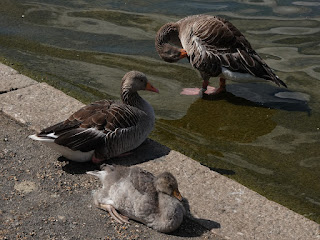The female Little Owl at the Round Pond was seen moving around in the hole at the back of the nest tree, a good sign as it means the intruding squirrels have gone. When I arrived she had gone out of sight, but I did find her mate well hidden in a horse chestnut tree.
The day before yesterday I heard what might have been the hissing of owlets here, but I was too far away to be sure and I haven't heard them since. Anyway, it's clear that things are happening here.
Also at the Round Pond, two young Pied Wagtails were running around on the noxious surface of the gravel strip.
A Blue Tit looked down regally from a magnolia leaf in the Flower Walk.
The older Great Tit fledglings are begging less and hunting more as they grow up. This is one of the more recent ones, still completely dependent on its parents.
Two Carrion Crows enjoyed a brawl.
The Great Crested Grebe pair at the bridge had a leisurely preen ...
... and went back to sleep comfortably together.
The Coot was gone from the nest site, so they should be free to move in. There's no hurry: the later they nest the more small fish there will be for the chicks.
The Coots under the parapet of the Italian Garden have built a second nest for themselves and their three chicks, one of which can be seen here. I don't think these extra nests serve any real purpose, it just is that Coots can't stop building.
The Mute Swans had parked their cygnets on the nesting island.
The longer they stay here, the better for the two single cygnets on the Serpentine.
The single Greylag gosling on the Serpentine is noticeably younger than the two from the other pair, but it has probably turned the corner and is likely to survive.
Nevertheless, what a sad showing we have had this year: three Greylags and four Canadas. As usual, the Egyptians have done quite well simply by being fantastically prolific.
Four Red Crested Pochard drakes rested on the gravel strip on the Long Water ...
... and there were two Mandarins. The one on the left seems to be female, with a grey bill, but it's hard to be sure at this distance.
Large carp swam around the Serpentine outflow. The biggest was about 2ft 6in (75 cm) long. There are considerably bigger fish farther out in the lake.
At last the dragonflies are beginning to pick up. I saw two male Emperors over the Long Water but they didn't provide a photo opportunity. And there were three male Black-Tailed Skimmers. This one was at Peter Pan. They like to rest on the gravel rolled into the tarmac, which makes a poor background.
There were some more interesting insects. A Potato Capsid bug, Closterotomus norvegicus, rested on an oxeye daisy in the Rose Garden ...
... and this ground beetle, I think Harpalus affinis, was literally beetling over the ground by the Henry Moore sculpture, so I couldn't get a good picture of it.















It's distressing that there should survive so few goslings. Geese are such attentive parents, it speaks to how many predators there are, and how difficult survival is.
ReplyDeleteIf there is such a thing as reincarnation, I want to come back as a Grebe. Not an eagle, not a polar bear, not a shark. A Grebe. The happiest creature on earth.
Tinúviel
The Serpentine is a very hostile place for goslings because of the large number of Herring Gulls. There's a breeding colony very near on the roof of a building or buildings in Paddington -- I don't know the details. No one can oppose the gulls because they are a protected species, in decline around the coast but expanding in London.
DeleteYes, I've often envied Grebes their simple pleasures and their real love for their mates.
A good variety of insects Ralph on the first decent day in a while. I went to the London Wetland Centre where there were a few dragonflies. Most numerous (at least 7) was amazingly Norfolk Hawker (one to look out for in the park!) followed by 5 each of Emperor & Black-tailed Skimmer, 4 4-spotted Chasers & rarest a Downy Emerald.
ReplyDeleteVery few butterflies though.
Always fun watching Crows & Magpies having a brawl.
A few more warm days forecast and we might get a late recovery of the missing insects. Hope so, since as summer sets in the small birds become less noticeable and less photographable, and if the blog veers from birds towards insects the readers seem to go along with it, Even the purist London Bird Club Wiki admits them in {curly braces}.
DeleteYes I add scarcer butterflies/dragonflies on the London Bird wiki.
Delete